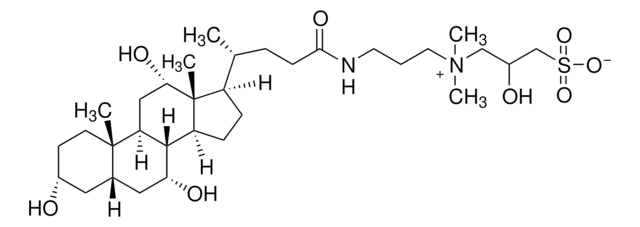O3757
Octyl β-D-glucopyranoside solution
≥95% (HPLC), 50 % (w/v) in H2O
Synonym(s):
n-Octyl glucoside, OGP
About This Item
Recommended Products
description
non-ionic
Assay
≥95% (HPLC)
mol wt
average mol wt 24500-25000
concentration
50 % (w/v) in H2O
aggregation number
84
CMC
20-25
transition temp
cloud point ≥100
application(s)
detection
storage temp.
−20°C
SMILES string
CCCCCCCCO[C@@H]1O[C@H](CO)[C@@H](O)[C@H](O)[C@H]1O
InChI
1S/C14H28O6/c1-2-3-4-5-6-7-8-19-14-13(18)12(17)11(16)10(9-15)20-14/h10-18H,2-9H2,1H3/t10-,11-,12+,13-,14-/m1/s1
InChI key
HEGSGKPQLMEBJL-RKQHYHRCSA-N
Related Categories
Application
Legal Information
Storage Class Code
10 - Combustible liquids
WGK
WGK 3
Flash Point(F)
Not applicable
Flash Point(C)
Not applicable
Certificates of Analysis (COA)
Search for Certificates of Analysis (COA) by entering the products Lot/Batch Number. Lot and Batch Numbers can be found on a product’s label following the words ‘Lot’ or ‘Batch’.
Already Own This Product?
Find documentation for the products that you have recently purchased in the Document Library.
Customers Also Viewed
Our team of scientists has experience in all areas of research including Life Science, Material Science, Chemical Synthesis, Chromatography, Analytical and many others.
Contact Technical Service











